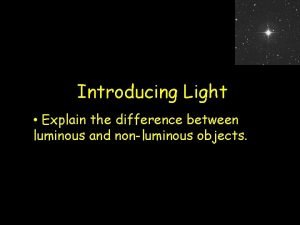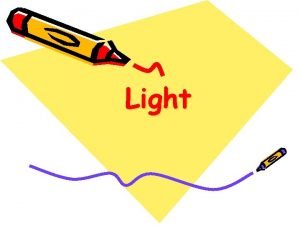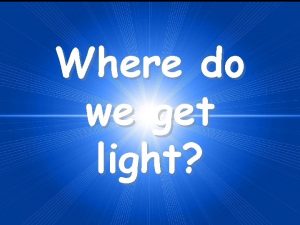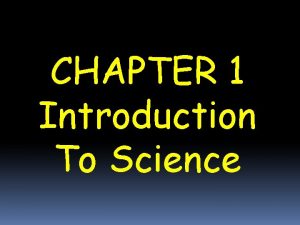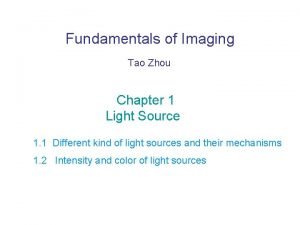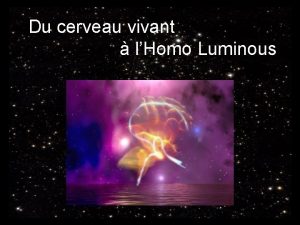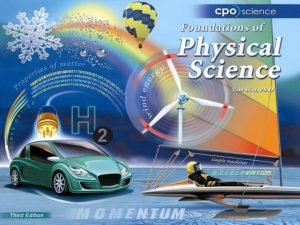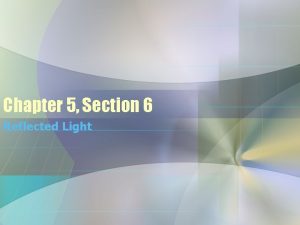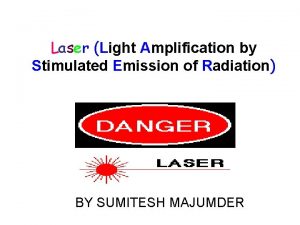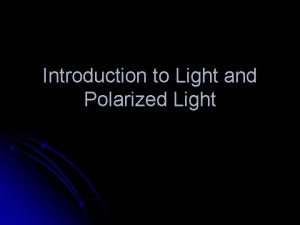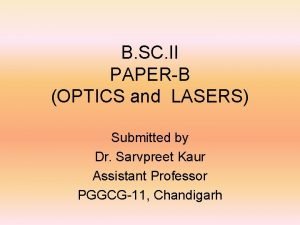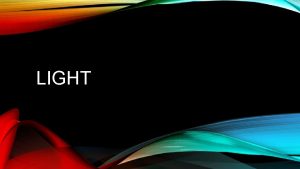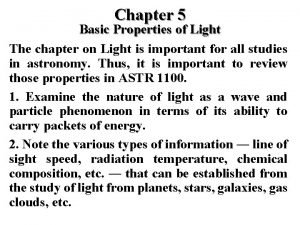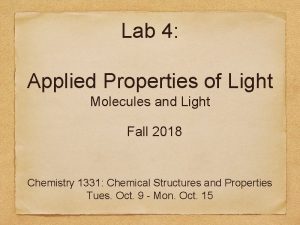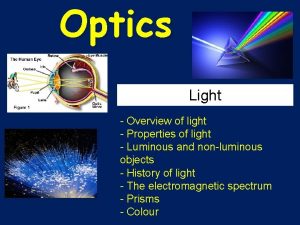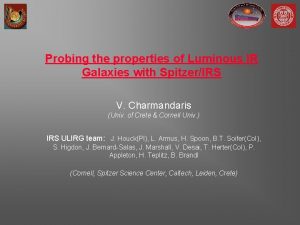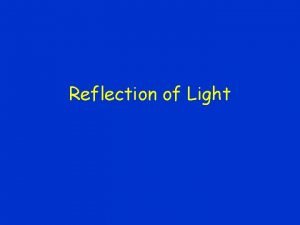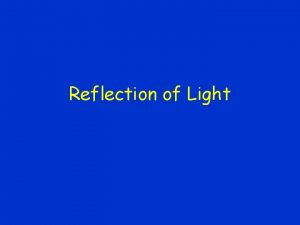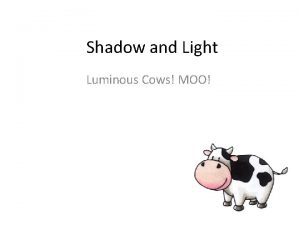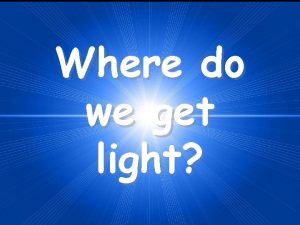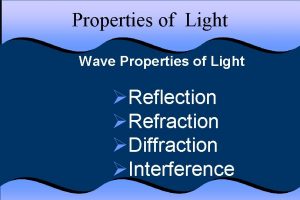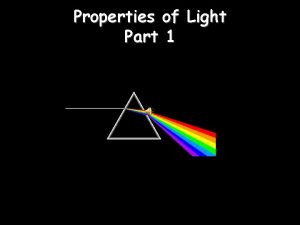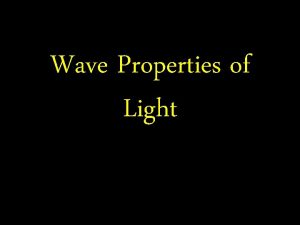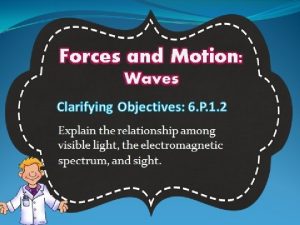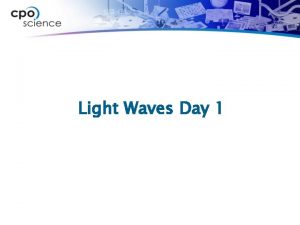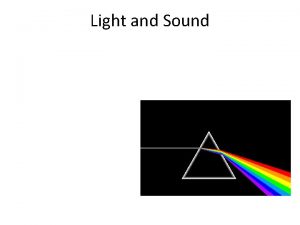Light Overview of light Properties of light Luminous




































- Slides: 36

Light - Overview of light - Properties of light - Luminous and non-luminous objects - The strangeness of light - The electromagnetic spectrum - Wavelength of frequency - Colour & Colour Blindness - The production of light - The speed of light

Where does light come from? The SUN!! • The sun is a star located 1. 50 x 108 km, or 1 Astronomical Unit, away from Earth. • It provides energy in the form of light through a process called nuclear fusion. • Nuclear fusion occurs when two atoms that naturally repel each other are pulled together by a superior force and the atoms fuse together. • Nuclear fusion produces energy that reaches us as heat and light.

• The sun provides the energy that enables life on Earth.

Properties of Light • Light travels in straight lines: Laser

• Light travels VERY FAST – 3. 0 x 108 m/s = 300, 000 kilometres per second. At this speed it can go around the world 7. 5 times in one second.

• Light travels much faster than sound. For example: Thunder and lightning start at the same time, but we will see the lightning first.

• We see things because they reflect light into our eyes: Homework

Luminous and non-luminous objects A luminous object is one that produces light. A non-luminous object is one that reflects light.

Properties of Light summary 1) Light travels in straight lines 2) Light travels much faster than sound 3) We see things because they reflect light into our eyes

The Strangeness of Light • Nothing moves faster than the speed of light 3. 0 x 108 m/s • Anything with mass cannot travel at the speed of light • Light is defined as a collection of one or more photons (particles) propagating through space as electromagnetic waves – therefore, it’s a particle and a wave • Unlike heat and sound energy, which require a medium (a physical substance) to move, light does not – Light is transferred through radiation (via electromagnetic waves) in a vacuum

Modern electromagnetic waves • Today we have identified many types of electromagnetic waves which make up our electromagnetic spectrum

The Electromagnetic Spectrum • Your eyes can only see the visible part of the EM spectrum, but your hands can feel the infrared part.

The Electromagnetic Spectrum • Machines can detect other parts of the EM spectrum, but the information needs to be converted into colours for us to see it.

Example – The Sun visible UVA x-ray UVB


Wavelength and Frequency • Wavelength – the distance between successive crests on a wave. • Frequency – the number of cycles a wave goes through in one second.

The Visible Light Spectrum • Different colours have different wavelengths!

Colour • White light is not a single colour; it is made up of a mixture of the seven colours of the rainbow. We can demonstrate this by splitting white light with a prism: This is how rainbows are formed: sunlight is “split up” by raindrops.

The colours of the rainbow: • • ROY-G-BIV Red Orange Yellow Green Blue Indigo Violet

Adding colours • White light can be split up to make separate colours. These colours can be added together again. • The primary colours of light are red, blue, and green: Adding blue and red makes magenta (purple) Adding red and green makes yellow Adding blue and green makes cyan (light blue) Adding all three makes white again

Seeing colour • The colour an object appears depends on the colours of light it reflects. For example, a red book only reflects red light : White light Only red light is reflected

A pair of purple pants would reflect purple light (and red and blue, as purple is made up of red and blue): Purple light A white hat would reflect all seven colours: White light

Colour Blindness • The tricky thing about colour blindness is that many people don’t know they are colour blind until they get tested – 40% of colour blind pupils currently leaving secondary school are unaware that they are colour blind There are of course advantages

How many animals are there?

6!

• Red Green Colour Blindness is caused by a gene on the X chromosome. Therefore, since males have 1 X and 1 Y while females carry 2 Xs, this issue is predominately found in males (7 -10% of the overall population) and is very rarely seen in females. • These people cannot see red and green light.

• Blue Colour Blindness is equally unlikely for both males and females as the deficient gene is found on chromosome 7. These people can’t see blue colour light • In both these cases the problem isn't as straight forward as not seeing blue, red, or green light. If what they are looking at contains these colours, they will not be seen.


What Colorblind People See

The Production of Light • Light is produced in three main ways: 1. Incandescence – Hot things glow

The Production of Light 2. Luminescence – Electrons jump around

The Production of Light 3. Chemiluminescence – Chemical reactions – Bioluminescence is a chemical reaction inside a living organism

The speed of light • The speed of light in a vacuum is a universal constant. – 300, 000 m/s • The speed of light in a medium is always slower than the speed of light in a vacuum.

How long will it take? Earth Moon 384, 000 m How long does light take to reach the Earth from the Sun (~93 million mi, 150 million km)? 8. 3 minutes

Looking Into The Past • By looking at objects in the universe (stars and galaxies), you are looking into the past. Why?

Looking Into The Past Object Time for the light to reach us The Moon The Sun 1. 3 seconds 8. 3 minutes Jupiter Pluto Alpha Centauri (nearest star) Sirius (Brightest star in our sky) Betelgeuse (Another bright star) Orion Nebula Andromeda Galaxy 35 to 52 minutes 5. 5 hours 4. 3 years 9 years 430 years 1500 years 2. 5 million years
 Examples of non luminous object
Examples of non luminous object Light is a form of *
Light is a form of * Carbon family
Carbon family Elements and their properties section 1 metals
Elements and their properties section 1 metals What is illuminated objects
What is illuminated objects What is luminous ball of gas?
What is luminous ball of gas? Non luminous flame
Non luminous flame Luminous efficacy comparison chart
Luminous efficacy comparison chart Homo luminous
Homo luminous Light light light chapter 23
Light light light chapter 23 Into the light chapter 22
Into the light chapter 22 Light light light chapter 22
Light light light chapter 22 Intensive property and extensive properties
Intensive property and extensive properties Is smell a physical property
Is smell a physical property U
U What are the 7 properties of light
What are the 7 properties of light 5 properties of light
5 properties of light Characteristics of lasers
Characteristics of lasers Stimulated emission
Stimulated emission Becke line definition
Becke line definition Properties of laser light
Properties of laser light Light behaves differently as it strikes different objects
Light behaves differently as it strikes different objects Basic properties of light
Basic properties of light 5 properties of light
5 properties of light Medical terminology ophthalmology
Medical terminology ophthalmology Properties of light lab
Properties of light lab Www stands for world wide web
Www stands for world wide web Maximo work order priority
Maximo work order priority Universal modeling language
Universal modeling language Uml overview
Uml overview Retail vertical
Retail vertical Figure 12-1 provides an overview of the lymphatic vessels
Figure 12-1 provides an overview of the lymphatic vessels Major veins of the body
Major veins of the body Texas recapture districts
Texas recapture districts Walmart company profile
Walmart company profile What is stylistic overview
What is stylistic overview Jackson structured development
Jackson structured development
